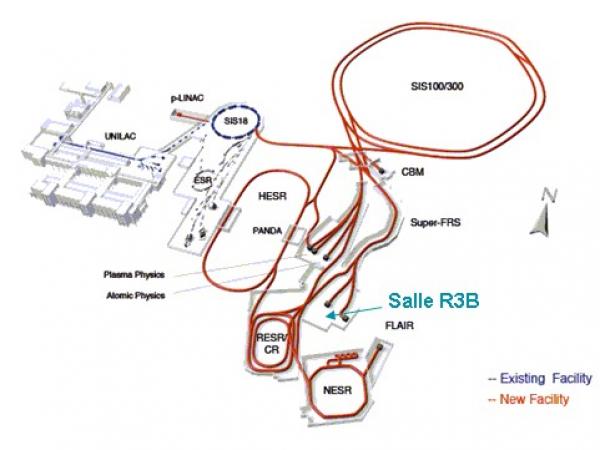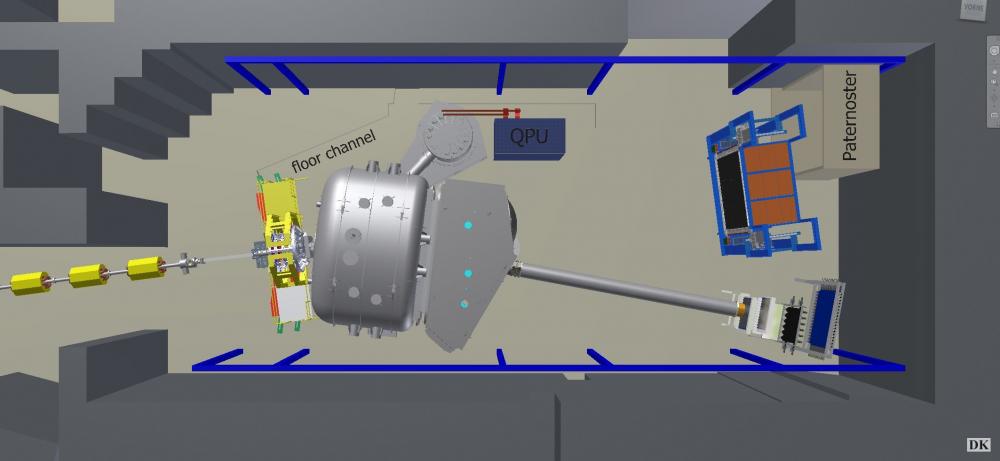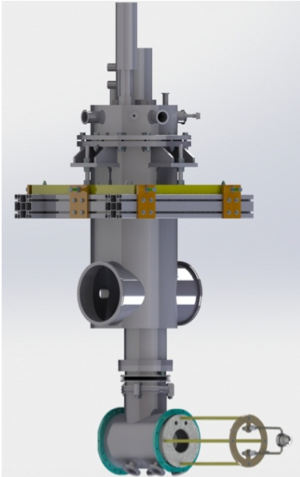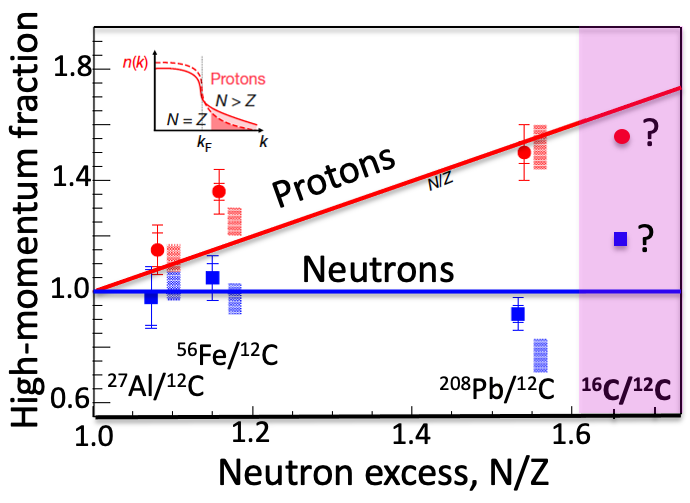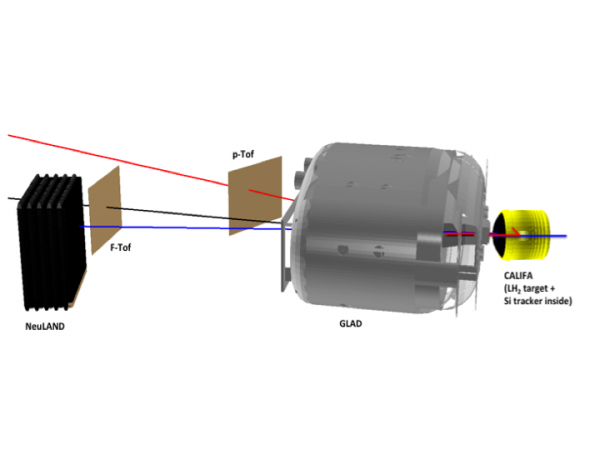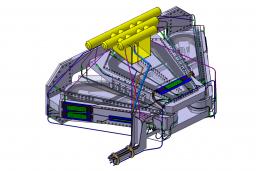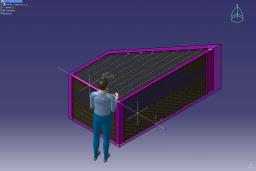Goals of the experiment
A major research focus of the LENA group at DPhN is the structure of exotic nuclei and, since more recently, the study of short-range correlations (SRC) in exotic nuclei. The GSI accelerator and, later, FAIR, are the ideal instruments to perform these kinds of measurements.
The energy (around 1 GeV per nucleon) necessary for these reactions as well as the high intensity of the secondary beams which will be available at the future FAIR/R3B facility create the necessity to build new experimental apparatus with improved performances: a central dipole magnet placed behind the reaction target providing a higher bending power and a larger angular aperture, faster detectors providing higher resolutions in the reconstruction of the kinematics at the reaction points. The construction of FAIR has been divided into different phases. The first one, called "phase 0", started in 2018 and will allow to perform experiments with the R3B device designed for FAIR and the beams delivered by the GSI accelerator, while waiting for the completion of the FAIR accelerator system.
Context
The RIKEN and NSCL/FRIB accelerators are the main competitors of GSI/FAIR. The RIKEN radioactive beam production facility, already in operation, can deliver primary beams with energies of 350 MeV per nucleon, lower than at R3B. FRIB, the NSCL upgrade under construction, aims at energies of 300 MeV per nucleon.
Compared to SPIRAL2, one should rather talk about complementarity rather than competition. Indeed, the mechanisms for producing radioactive beams are very different between the two installations, which means that the beams available will also be different, since SPIRAL 2 will specialize in beams produced with uranium-238 fission fragments. Similarly, the energies of the SPIRAL 2 beams will be of the order of a few MeV per nucleon, compared to the hundreds of MeV of the beams that will be used at R3B.
IRFU contributions
IRFU has designed and built GLAD (GSI Large Acceptance Dipole) spectrometer, a key element of the R3B device which was delivered in 2015 and used since 2018. Moreover, the IRFU has designed and realized, in the framework of the ANR COCOTIER project, a liquid hydrogen target which was used for the first time in March 2021. This is an asset to perform experiments based on a quasifree scattering reaction, such as the study of short range correlations and several other experiments at the heart of the R3B program.
Contacts
Scientific leader of COCOTIER:
R3B-GLAD project manager: Bernard Gastineau
Scientific challenges and project framework
The COCOTIER project (for short-range COrrelations and Isotopic spin at R3B - COrrélations à COurte porTée et spin IsotopiquE à R3B) aims at studying short-range correlations in exotic nuclei produced by fragmentation at the radioactive ion beam factory GSI and, later on, FAIR. Short-range correlations formed by the combination of the intermediate-range attraction with the short-range repulsive term of the nucleon-nucleon potential pairs nucleons in a very compact spatial configuration (1-1.5 fm) with a large relative momentum. That is the reason why those correlations may provide a way to probe in the laboratory the short-range part of the nucleon-nucleon interaction.
Those correlations were studied only in the region of the stable nuclei with values of the asymetry ratio between neutron and proton numbers (N/Z) close to 1 (N/Z~1-1.5). Those studies were mainly carried out with a series of experiments done at the electron accelerator of Jefferson Lab, JLab (United States). These measurements are limited to stable nuclei, and they were obtained with a low statistics. The objective of the COCOTIER project is to overcome these two limitations by performing measurements at high luminosity in inverse kinematics. The study of the short-range correlations in 16C (and 12C as a reference) will be the goal of the first experiment at the R3B facility, scheduled in May 2022.
Technical details
For the study of these correlations, we use the mechanism of quasi free scattering in inverse kinematics: the exotic ion beam is sent on a proton target, and all the reaction products are subsequently detected. It is then possible to count the pair numbers, and to deduce the momentum of the nucleons forming the pair. To perform this experiment, a liquid Hydrogen target has beeen built at IRFU. It will be coupled to the R3B detection system. This system combines a trajectograph (Silicon tracker), the CALIFA calorimeter, the NeuLAND neutron detector, and the analysis system of the fragment residue and of the charged particles, which are emitted at forward angles and deviated by the magnetic field of GLAD, a very large acceptance dipolar magnet built at IRFU.
Project schedule
The COCOTIER project is funded with an ANR (project PI: IRFU, A. Corsi) starting from October 1st, 2017. The Liquid H2 target has been built at IRFU and installed at GSI end 2019. The first experiment with the COCOTIER target was performed in March 2022. Two other experiments, including the measurement of Short Range Correlations, were approved by the GSI Program Advisory Committee in 2020 and are currently planned for 2022.
Contact : IRFU, DPhN
Introduction
Goals of the project:
GLAD is being designed in order to reach four main goals:
Localisation:
The GLAD magnet will be used in the R3B hall of the FAIR facility in GSI, Darmstadt, Germany.
Contacts
The funding of the construction of the R3B-GLAD dipole magnet is provided by the European Union within the 6th framework programme, GSI and the DAPNIA. The DAPNIA project team on this magnet is fully in charge of its design and of its construction.
The DAPNIA in CEA-Saclay is the only research institution working on the realisation of the GLAD magnet.
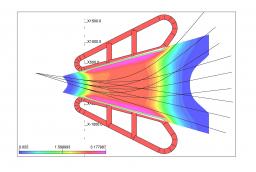
Magnetic field map of GLAD. The red lines are different tracks of particles in the magnetic field volume.
INSTRUMENTATION (ONGLET)
Specificities of the project & technical description
DESCRIPTION OF THE PROJECT
Physics and programmes:
Innovation for detection systems/Detector developments
Nuclear matter in its extreme states / Exotic nuclei
Goals of the project
Size of the project
CONTACTS
Scientific leader : Jean-eric DUCRET
TPC design study leader : Philippe LEGOU
INSTRUMENTATION
Instrument
time projection chamber (TPC)
Technical description
o Active volume: H = 90 cm, L = 120 cm, W = 120 cm (entrance) & 250 cm (exit)
• Structure of nuclear matter › Atomic nucleus
• The Nuclear Physics Division • Accelerators, Cryogenics and Magnetism Division (DACM)

